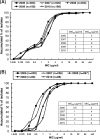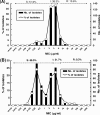Trends in the susceptibility of clinically important resistant bacteria to tigecycline: results from the Tigecycline In Vitro Surveillance in Taiwan study, 2006 to 2010
- PMID: 22203598
- PMCID: PMC3294947
- DOI: 10.1128/AAC.06053-11
Trends in the susceptibility of clinically important resistant bacteria to tigecycline: results from the Tigecycline In Vitro Surveillance in Taiwan study, 2006 to 2010
Abstract
The Tigecycline In Vitro Surveillance in Taiwan (TIST) study, a nationwide, prospective surveillance during 2006 to 2010, collected a total of 7,793 clinical isolates, including methicillin-resistant Staphylococcus aureus (MRSA) (n = 1,834), penicillin-resistant Streptococcus pneumoniae (PRSP) (n = 423), vancomycin-resistant enterococci (VRE) (n = 219), extended-spectrum β-lactamase (ESBL)-producing Escherichia coli (n = 1,141), ESBL-producing Klebsiella pneumoniae (n = 1,330), Acinetobacter baumannii (n = 1,645), and Stenotrophomonas maltophilia (n = 903), from different specimens from 20 different hospitals in Taiwan. MICs of tigecycline were determined following the criteria of the U.S. Food and Drug Administration (FDA) and the European Committee on Antimicrobial Susceptibility Testing (EUCAST-2011). Among drug-resistant Gram-positive pathogens, all of the PRSP isolates were susceptible to tigecycline (MIC(90), 0.03 μg/ml), and only one MRSA isolate (MIC(90), 0.5 μg/ml) and three VRE isolates (MIC(90), 0.125 μg/ml) were nonsusceptible to tigecycline. Among the Gram-negative bacteria, the tigecycline susceptibility rates were 99.65% for ESBL-producing E. coli (MIC(90), 0.5 μg/ml) and 96.32% for ESBL-producing K. pneumoniae (MIC(90), 2 μg/ml) when interpreted by FDA criteria but were 98.7% and 85.8%, respectively, when interpreted by EUCAST-2011 criteria. The susceptibility rate for A. baumannii (MIC(90), 4 μg/ml) decreased from 80.9% in 2006 to 55.3% in 2009 but increased to 73.4% in 2010. A bimodal MIC distribution was found among carbapenem-susceptible A. baumannii isolates, and a unimodal MIC distribution was found among carbapenem-nonsusceptible A. baumannii isolates. In Taiwan, tigecycline continues to have excellent in vitro activity against several major clinically important drug-resistant bacteria, with the exception of A. baumannii.
Figures



Similar articles
-
Agreement assessment of tigecycline susceptibilities determined by the disk diffusion and broth microdilution methods among commonly encountered resistant bacterial isolates: results from the Tigecycline In Vitro Surveillance in Taiwan (TIST) study, 2008 to 2010.Antimicrob Agents Chemother. 2012 Mar;56(3):1414-7. doi: 10.1128/AAC.05879-11. Epub 2011 Dec 12. Antimicrob Agents Chemother. 2012. PMID: 22155819 Free PMC article.
-
Update on antimicrobial susceptibility rates among gram-negative and gram-positive organisms in the United States: results from the Tigecycline Evaluation and Surveillance Trial (TEST) 2005 to 2007.Clin Ther. 2008 Nov;30(11):2040-50. doi: 10.1016/j.clinthera.2008.11.006. Clin Ther. 2008. PMID: 19108792
-
The tigecycline evaluation and surveillance trial; assessment of the activity of tigecycline and other selected antibiotics against gram-positive and gram-negative pathogens from France collected between 2004 and 2016.Antimicrob Resist Infect Control. 2018 May 30;7:68. doi: 10.1186/s13756-018-0360-y. eCollection 2018. Antimicrob Resist Infect Control. 2018. PMID: 29876099 Free PMC article.
-
Susceptibility of contemporary isolates to fosfomycin: a systematic review of the literature.Int J Antimicrob Agents. 2016 Apr;47(4):269-85. doi: 10.1016/j.ijantimicag.2016.02.001. Epub 2016 Feb 24. Int J Antimicrob Agents. 2016. PMID: 27013000
-
In vitro antibacterial activity of doripenem against clinical isolates from French teaching hospitals: proposition of zone diameter breakpoints.Eur J Clin Microbiol Infect Dis. 2011 Apr;30(4):475-82. doi: 10.1007/s10096-010-1117-6. Epub 2010 Nov 19. Eur J Clin Microbiol Infect Dis. 2011. PMID: 21088861 Review.
Cited by
-
The impact of inappropriate antibiotics on bacteremia patients in a community hospital in Taiwan: an emphasis on the impact of referral information for cases from a hospital affiliated nursing home.BMC Infect Dis. 2013 Oct 24;13:500. doi: 10.1186/1471-2334-13-500. BMC Infect Dis. 2013. PMID: 24156241 Free PMC article.
-
Antimicrobial susceptibility of stenotrophomonas maltophilia isolates from Korea, and the activity of antimicrobial combinations against the isolates.J Korean Med Sci. 2013 Jan;28(1):62-6. doi: 10.3346/jkms.2013.28.1.62. Epub 2013 Jan 8. J Korean Med Sci. 2013. PMID: 23341713 Free PMC article.
-
The role of doxycycline in the therapy of multidrug-resistant E. coli - an in vitro study.Sci Rep. 2016 Aug 18;6:31964. doi: 10.1038/srep31964. Sci Rep. 2016. PMID: 27534373 Free PMC article.
-
Molecular characteristics of vancomycin-resistant Enterococcus faecium from a tertiary care hospital in Chengdu, China: molecular characteristics of VRE in China.Eur J Clin Microbiol Infect Dis. 2014 Jun;33(6):933-9. doi: 10.1007/s10096-013-2029-z. Epub 2014 Jan 24. Eur J Clin Microbiol Infect Dis. 2014. PMID: 24463723
-
Characterization of Tigecycline-Heteroresistant Klebsiella pneumoniae Clinical Isolates From a Chinese Tertiary Care Teaching Hospital.Front Microbiol. 2021 Aug 3;12:671153. doi: 10.3389/fmicb.2021.671153. eCollection 2021. Front Microbiol. 2021. PMID: 34413834 Free PMC article.
References
-
- Boucher HW, et al. 2009. Bad bugs, no drugs: no ESKAPE! An update from the Infectious Diseases Society of America. Clin. Infect. Dis. 48:1–12 - PubMed
-
- Bouchillon SK, Iredell JR, Barkham T, Lee K, Dowzicky MJ. 2009. Comparative in vitro activity of tigecycline and other antimicrobials against Gram-negative and Gram-positive organisms collected from the Asia-Pacific Rim as part of the Tigecycline Evaluation and Surveillance Trial (TEST). Int. J. Antimicrob. Agents 33:130–136 - PubMed
-
- Chen YH, et al. 2011. Antimicrobial susceptibility profiles of aerobic and facultative Gram-negative bacilli isolated from patients with intra-abdominal infections in the Asia-Pacific region according to currently established susceptibility interpretive criteria. J. Infect. 62:280–291 - PubMed
-
- Chen WY, Jang TN, Huang CH, Hsueh PR. 2009. In vitro susceptibilities of aerobic and facultative anaerobic Gram-negative bacilli isolated from patients with intra-abdominal infections at a medical center in Taiwan: results of the Study for Monitoring Antimicrobial Resistance Trends (SMART) 2002-2006. J. Microbiol. Immunol. Infect. 42:317–323 - PubMed
Publication types
MeSH terms
Substances
LinkOut - more resources
Full Text Sources
Medical

